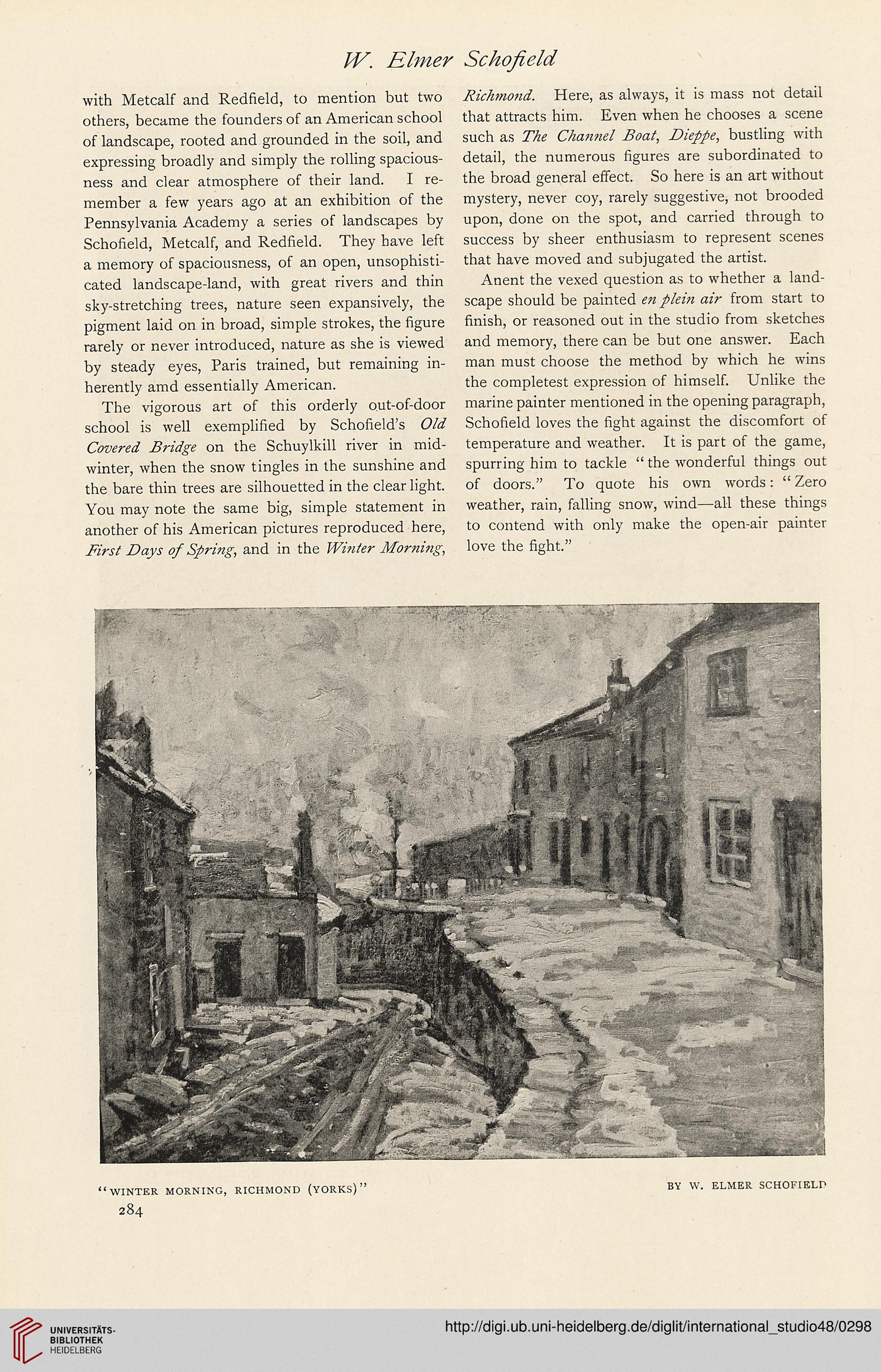W. Elmer Schofield
with Metcalf and Redfield, to mention but two
others, became the founders of an American school
of landscape, rooted and grounded in the soil, and
expressing broadly and simply the rolling spacious-
ness and clear atmosphere of their land. I re-
member a few years ago at an exhibition of the
Pennsylvania Academy a series of landscapes by
Schofield, Metcalf, and Redfield. They have left
a memory of spaciousness, of an open, unsophisti-
cated landscape-land, with great rivers and thin
sky-stretching trees, nature seen expansively, the
pigment laid on in broad, simple strokes, the figure
rarely or never introduced, nature as she is viewed
by steady eyes, Paris trained, but remaining in-
herently amd essentially American.
The vigorous art of this orderly out-of-door
school is well exemplified by Schofield’s Old
Covered Bridge on the Schuylkill river in mid-
winter, when the snow tingles in the sunshine and
the bare thin trees are silhouetted in the clear light.
You may note the same big, simple statement in
another of his American pictures reproduced here,
First Days of Spring, and in the Winter Morning,
Richmond. Here, as always, it is mass not detail
that attracts him. Even when he chooses a scene
such as The Channel Boat, Dieppe, bustling with
detail, the numerous figures are subordinated to
the broad general effect. So here is an art without
mystery, never coy, rarely suggestive, not brooded
upon, done on the spot, and carried through to
success by sheer enthusiasm to represent scenes
that have moved and subjugated the artist.
Anent the vexed question as to whether a land-
scape should be painted en plein air from start to
finish, or reasoned out in the studio from sketches
and memory, there can be but one answer. Each
man must choose the method by which he wins
the completest expression of himself. Unlike the
marine painter mentioned in the opening paragraph,
Schofield loves the fight against the discomfort of
temperature and weather. It is part of the game,
spurring him to tackle “ the wonderful things out
of doors.” To quote his own words: “ Zero
weather, rain, falling snow, wind—all these things
to contend with only make the open-air painter
love the fight.”
“WINTER MORNING, RICHMOND (YORKS)”
284
BY W. ELMER SCHOFIELD
with Metcalf and Redfield, to mention but two
others, became the founders of an American school
of landscape, rooted and grounded in the soil, and
expressing broadly and simply the rolling spacious-
ness and clear atmosphere of their land. I re-
member a few years ago at an exhibition of the
Pennsylvania Academy a series of landscapes by
Schofield, Metcalf, and Redfield. They have left
a memory of spaciousness, of an open, unsophisti-
cated landscape-land, with great rivers and thin
sky-stretching trees, nature seen expansively, the
pigment laid on in broad, simple strokes, the figure
rarely or never introduced, nature as she is viewed
by steady eyes, Paris trained, but remaining in-
herently amd essentially American.
The vigorous art of this orderly out-of-door
school is well exemplified by Schofield’s Old
Covered Bridge on the Schuylkill river in mid-
winter, when the snow tingles in the sunshine and
the bare thin trees are silhouetted in the clear light.
You may note the same big, simple statement in
another of his American pictures reproduced here,
First Days of Spring, and in the Winter Morning,
Richmond. Here, as always, it is mass not detail
that attracts him. Even when he chooses a scene
such as The Channel Boat, Dieppe, bustling with
detail, the numerous figures are subordinated to
the broad general effect. So here is an art without
mystery, never coy, rarely suggestive, not brooded
upon, done on the spot, and carried through to
success by sheer enthusiasm to represent scenes
that have moved and subjugated the artist.
Anent the vexed question as to whether a land-
scape should be painted en plein air from start to
finish, or reasoned out in the studio from sketches
and memory, there can be but one answer. Each
man must choose the method by which he wins
the completest expression of himself. Unlike the
marine painter mentioned in the opening paragraph,
Schofield loves the fight against the discomfort of
temperature and weather. It is part of the game,
spurring him to tackle “ the wonderful things out
of doors.” To quote his own words: “ Zero
weather, rain, falling snow, wind—all these things
to contend with only make the open-air painter
love the fight.”
“WINTER MORNING, RICHMOND (YORKS)”
284
BY W. ELMER SCHOFIELD




